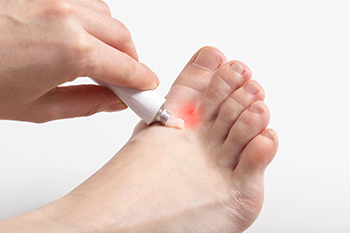Merrillville, IN
Munster, IN
Treating Athlete’s Foot
Tuesday, 06 August 2024 00:00 Athlete's foot, or tinea pedis, is a common fungal infection that affects the skin of the feet. It is caused by dermatophytes, fungi thriving in warm, moist environments like shoes, locker rooms, and swimming pools. Symptoms can include itching, stinging, and burning between the toes or on the soles, in addition to blisters, cracking, peeling, and dry skin. Risk factors include walking barefoot in communal areas, sharing footwear, having sweaty feet, and wearing tight-fitting shoes. People with weakened immune systems or diabetes are particularly susceptible. Treatment involves antifungal medications, available as creams, sprays, powders, or oral medications. Keeping feet clean and dry, changing socks regularly, and using antifungal powders can prevent recurrence. Complications can arise if left untreated, such as secondary bacterial infections, spreading to other body parts, and chronic infection. If you have a severe case of athlete’s foot, it is suggested that you visit a podiatrist for more aggressive treatment and medical supervision.
Athlete's foot, or tinea pedis, is a common fungal infection that affects the skin of the feet. It is caused by dermatophytes, fungi thriving in warm, moist environments like shoes, locker rooms, and swimming pools. Symptoms can include itching, stinging, and burning between the toes or on the soles, in addition to blisters, cracking, peeling, and dry skin. Risk factors include walking barefoot in communal areas, sharing footwear, having sweaty feet, and wearing tight-fitting shoes. People with weakened immune systems or diabetes are particularly susceptible. Treatment involves antifungal medications, available as creams, sprays, powders, or oral medications. Keeping feet clean and dry, changing socks regularly, and using antifungal powders can prevent recurrence. Complications can arise if left untreated, such as secondary bacterial infections, spreading to other body parts, and chronic infection. If you have a severe case of athlete’s foot, it is suggested that you visit a podiatrist for more aggressive treatment and medical supervision.
Athlete’s foot is an inconvenient condition that can be easily reduced with the proper treatment. If you have any concerns about your feet and ankles, contact Ahmad Elsamad, DPM from The Institute of Foot & Ankle Reconstructive Surgery . Our doctor will treat your foot and ankle needs.
Athlete’s Foot: The Sole Story
Athlete's foot, also known as tinea pedis, can be an extremely contagious foot infection. It is commonly contracted in public changing areas and bathrooms, dormitory style living quarters, around locker rooms and public swimming pools, or anywhere your feet often come into contact with other people.
Solutions to Combat Athlete’s Foot
- Hydrate your feet by using lotion
- Exfoliate
- Buff off nails
- Use of anti-fungal products
- Examine your feet and visit your doctor if any suspicious blisters or cuts develop
Athlete’s foot can cause many irritating symptoms such as dry and flaking skin, itching, and redness. Some more severe symptoms can include bleeding and cracked skin, intense itching and burning, and even pain when walking. In the worst cases, Athlete’s foot can cause blistering as well. Speak to your podiatrist for a better understanding of the different causes of Athlete’s foot, as well as help in determining which treatment options are best for you.
If you have any questions please feel free to contact our offices located in Merrillville, and Munster, IN . We offer the newest diagnostic and treatment technologies for all your foot and ankle needs.







